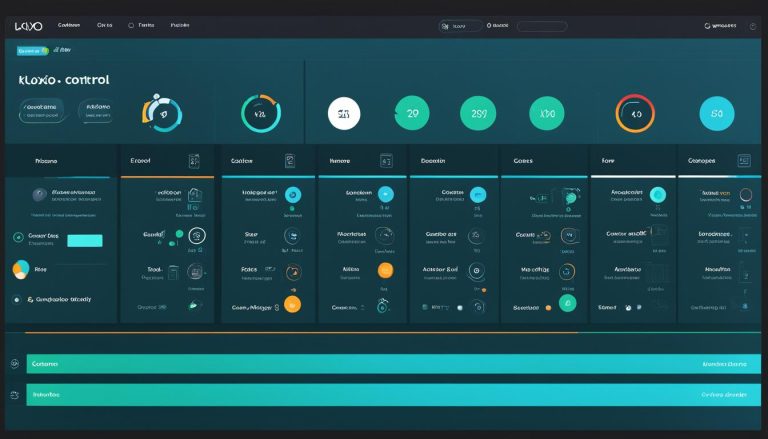What is OLTP in Database Management Systems
As a journalist specializing in copywriting for technology topics, I am excited to delve into the world of online transaction processing (OLTP) in database management systems. In this article, I will guide you through the intricacies of OLTP, explaining its definition, meaning, and importance in today’s digital landscape.
OLTP, or online transaction processing, is a crucial component of data processing that enables the execution of concurrent transactions in real-time. This includes activities such as online banking, shopping, and order entry. In fact, OLTP has become synonymous with any digital interaction or engagement with a business.
OLTP systems play a vital role in collecting, managing, and securing transaction data for businesses. They involve inserting, updating, and deleting small amounts of data in a data store, ensuring the accuracy and integrity of transactional information. These systems are characterized by their ACID compliance, which guarantees transaction accuracy, and their ability to handle large volumes of transactions, provide fast response times, and ensure data concurrency.
Key Takeaways:
- OLTP systems enable the execution of concurrent transactions in real-time, such as online banking and shopping.
- They play a critical role in collecting, managing, and securing transaction data for businesses.
- OLTP systems are characterized by their ACID compliance and their ability to handle large volumes of transactions with fast response times.
- These systems contribute to the accuracy and integrity of transactional data, ensuring data concurrency.
- Understanding OLTP is essential for businesses to make informed decisions based on real-time data.
OLTP Versus OLAP: Understanding the Difference
When discussing database management systems, it is crucial to differentiate between OLTP (Online Transaction Processing) and OLAP (Online Analytical Processing) systems. While both play important roles in handling data, they have distinct purposes and functionalities.
OLTP Systems:
An OLTP system is designed to facilitate real-time transaction processing, involving a large volume of concurrent transactions. These systems excel at handling small-scale data modifications, such as inserting, updating, and deleting records. OLTP systems prioritize fast response times and concurrency, making them suitable for applications like online banking, e-commerce, and order fulfillment.
OLAP Systems:
On the other hand, OLAP systems are optimized for analytical purposes. They are used to query and analyze large volumes of data, providing deeper business intelligence and supporting complex analysis. OLAP systems are focused on extracting insights, generating reports, and aiding decision-making processes. These systems are commonly used for data mining, data warehousing, and strategic planning within organizations.
Although there are differences between OLTP and OLAP, it is important to note that they complement each other in processing transactional data and extracting valuable insights. While OLTP systems ensure efficient transaction execution and data concurrency, OLAP systems enable complex analysis to uncover trends, patterns, and correlations.
OLTP Versus OLAP: A Comprehensive Comparison
| OLTP Systems | OLAP Systems |
|---|---|
| Real-time transaction processing | Analytical purposes |
| Handles large numbers of small-scale transactions | Queries large amounts of data |
| Fast response times and concurrency | Optimized for complex analysis |
In summary, understanding the difference between OLTP and OLAP systems is essential for businesses to effectively manage and utilize their data. Both systems have distinct roles in the data processing landscape, with OLTP focusing on transaction execution and OLAP enabling analytical insights. By leveraging the strengths of OLTP and OLAP, organizations can make more informed decisions, improve service delivery, and drive business growth.
Characteristics of OLTP Systems
OLTP systems, or Online Transaction Processing systems, possess a range of notable characteristics and features that make them essential components of modern database management. These systems are specifically designed to handle a high volume of concurrent users accessing data and frequent data modifications.
Data integrity is a fundamental aspect of OLTP systems, ensuring the accuracy and consistency of transactional data. Through the strict enforcement of transactional order and prevention of simultaneous data changes, OLTP systems maintain the reliability and trustworthiness of the stored information.
OLTP transactions typically involve small amounts of data and simple queries. This allows for efficient processing and quick response times, supporting the swift execution of real-time transactions. Indexed data sets are employed in OLTP systems to facilitate fast search and retrieval operations, enabling users to access the required information promptly.
One of the key benefits of OLTP systems is their ability to provide fast response times and high availability. These systems are optimized for delivering real-time transaction processing, ensuring that businesses can handle a vast number of transactions efficiently and without disruptions.
However, challenges exist within OLTP systems as well. Data overload is a common challenge, as these systems must handle the constant influx of transactions from multiple sources. Data silos may form, further complicating data management and integration across different systems and departments.
Another limitation of OLTP systems is their limited analysis capabilities. While OLTP systems excel at transactional processing, they may lack the sophisticated analytical tools required for complex data analysis and deeper business intelligence.
Hardware-related shortcomings, such as scalability and performance limitations, can pose challenges for OLTP systems. System architecture and database design play a crucial role in addressing these challenges and ensuring optimal performance under high transaction loads.
Benefits of OLTP Systems:
- High volume transaction processing
- Real-time data execution
- Data integrity and consistency
- Efficient processing of small data amounts
- Fast response times
- High availability
Challenges of OLTP Systems:
- Data overload
- Data silos
- Limited analysis capabilities
- Hardware-related shortcomings
Databases for OLTP Workloads
When it comes to handling OLTP workloads, relational databases are the go-to choice for businesses. These databases have proven their efficiency in managing large volumes of queries and updates while ensuring fast response times. Relational databases are purpose-built to handle OLTP transactions, offering a range of characteristics that make them ideal for this type of workload.
One of the key attributes of relational databases is their ability to ensure data concurrency. This means that multiple users can access and modify data simultaneously without any conflicts or inconsistencies. Additionally, relational databases adhere to the ACID (Atomicity, Consistency, Isolation, Durability) principles, which guarantee the accuracy, integrity, and durability of transactional data.
Relational databases organize data in tables, creating a structured environment for storing and retrieving information. This table-based structure allows for efficient indexing, which further enhances the performance of OLTP systems. Indexing enables fast search and retrieval of data, making it easier for businesses to process transactions quickly and maintain optimal response times.
Moreover, relational databases provide reliability, security, and recoverability. These databases are designed to ensure the integrity of transactional data, minimizing the risk of data loss or corruption. With robust backup and recovery mechanisms in place, businesses can rest assured that their valuable transactional data is protected and can be restored if necessary.
As technology and business requirements have evolved, so have relational databases. They have adapted to handle modern-day transactions that involve a wide range of workloads, including mixed workloads and global scale. This versatility and scalability make relational databases a reliable choice for businesses of all sizes and industries.
Overall, relational databases stand out as the preferred option for OLTP workloads due to their ability to handle large volumes of transactions, maintain fast response times, ensure data concurrency, and provide reliability and security. These databases play a crucial role in supporting businesses’ transactional activities and ensuring the smooth operation of critical systems.

- Relational databases are commonly used for OLTP workloads.
- They can handle large numbers of queries and updates while maintaining fast response times.
- Relational databases ensure data concurrency, ACID compliance, and accurate storage of transaction data.
- They organize data in tables and support indexing for improved performance.
- Relational databases offer reliability, security, and recoverability.
- They have evolved to handle modern-day transactions, including mixed workloads and global scale.
Benefits and Challenges of OLTP
OLTP systems, or Online Transaction Processing systems, offer numerous advantages that contribute to their significance in database management systems. These benefits include:
- Concurrency: OLTP systems allow multiple users to access and modify data simultaneously, ensuring efficient and smooth transaction processing.
- Atomicity: OLTP systems guarantee the order and accuracy of real-time transactions, maintaining data integrity and consistency.
- Business Insights: OLTP systems provide valuable insights into business operations by capturing and organizing transactional data, enabling informed decision-making and strategic planning.
- Usability: OLTP systems offer user-friendly interfaces and intuitive features, making transaction execution and data retrieval quick and straightforward for users.
- Speed: OLTP systems are designed to handle a high volume of small-scale transactions with fast response times, ensuring efficient real-time data processing.
Despite their advantages, OLTP systems also face certain challenges and limitations:
- Data Overload: As the volume of transactions increases, OLTP systems may struggle to handle the influx of data, resulting in performance issues and potential system slowdowns.
- Data Silos: Data in OLTP systems can become fragmented and isolated within separate databases, making it challenging to access and analyze unified information across the organization.
- Limited Analysis Capabilities: OLTP systems primarily focus on transaction processing and lack sophisticated analytical capabilities for complex data analysis and reporting.
- Issues for Small to Medium-Sized Businesses: Implementing and maintaining OLTP systems may impose significant costs on small to medium-sized businesses, often requiring dedicated resources and specialized expertise.
- Hardware-Related Shortcomings: OLTP systems rely on robust hardware infrastructure to ensure constant availability, high throughput, and efficient performance. Any hardware failures or limitations can negatively impact the system’s overall functionality.
Overcoming these challenges requires careful planning, ongoing optimization, and, in some cases, the integration of additional technologies or systems to enhance OLTP capabilities.
Conclusion
OLTP, or Online Transaction Processing, is a vital component of database management systems. Its ability to execute real-time transactions and ensure the accuracy and integrity of transactional data makes it indispensable in various industries, including finance, e-commerce, and record keeping. The characteristics of OLTP systems, such as handling high volumes of concurrent users and frequent data modifications, make them essential for businesses to collect, manage, and secure transaction data.
Recognizing the benefits and challenges of OLTP systems is crucial for businesses to harness the power of transaction processing. OLTP systems offer advantages like concurrency and atomicity, enabling fast and accurate real-time transactions. They provide valuable insights, usability, and speed in conducting transactions. However, challenges such as data overload, limited analysis capabilities, and hardware-related shortcomings need to be managed effectively to maximize the potential of OLTP systems.
In summary, OLTP is a cornerstone of database management systems, facilitating real-time transaction execution and ensuring the integrity of transactional data. Its role in various industries and its ability to provide businesses with up-to-date insights for decision-making cannot be overstated. By understanding the characteristics, benefits, and challenges of OLTP systems, businesses can optimize transaction processing and make informed decisions based on real-time data.
FAQ
What is OLTP?
OLTP stands for Online Transaction Processing. It refers to a type of data processing that involves executing concurrent transactions, such as online banking, shopping, and order entry. OLTP systems are critical for businesses to collect, manage, and secure transaction data.
What is the difference between OLTP and OLAP systems?
OLTP systems focus on executing real-time transactions involving small amounts of data modification. On the other hand, OLAP systems are designed for analytical purposes and involve querying large amounts of data. Both types of systems play complementary roles in processing transactional data and extracting insights for decision-making.
What are the characteristics of OLTP systems?
OLTP systems handle a high volume of concurrent users accessing data and frequent data modifications. They ensure data integrity through transactional order and prevention of simultaneous data changes. OLTP transactions typically involve small amounts of data and simple queries. Indexed data sets are used for fast search and retrieval, and OLTP systems provide fast response times and high availability.
What databases are commonly used for OLTP workloads?
Relational databases are commonly used for OLTP workloads due to their ability to handle large numbers of queries and updates while providing fast response times. Relational databases ensure data concurrency, ACID compliance, and accurate storage of transaction data. They store data in tables and support indexing for improved performance.
What are the benefits and challenges of OLTP?
OLTP systems offer benefits such as concurrency and atomicity, ensuring the order and accuracy of real-time transactions. They provide business insights, usability, and speed in executing transactions. However, challenges in OLTP systems include data overload, data silos, limited analysis capabilities, and hardware-related shortcomings.
What is the importance of OLTP in database management systems?
OLTP is a fundamental aspect of database management systems as it enables the execution of real-time transactions and ensures the accuracy and integrity of transactional data. It plays a critical role in various industries, including finance, e-commerce, and record keeping.
- About the Author
- Latest Posts
Mark is a senior content editor at Text-Center.com and has more than 20 years of experience with linux and windows operating systems. He also writes for Biteno.com






